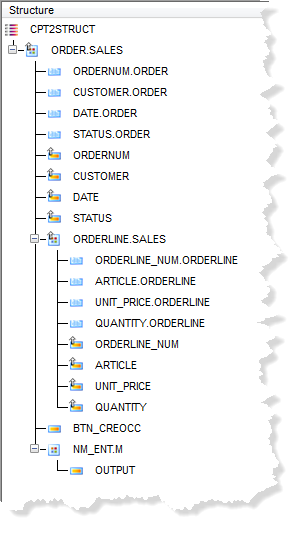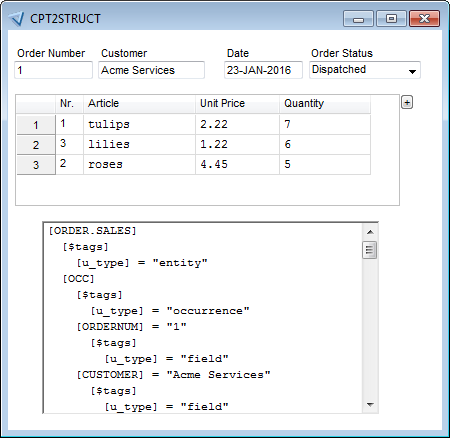componentToStruct
Writes component data to a Struct.
componentToStruct
{/mod} {/one}
{/reconnecttags} {/firetriggers}
StructTarget {, EntityName}
Example: componentToStruct /mod /reconnecttags
/firetriggers vStruct, EMPLOYEE.ORG
Qualifiers
| Qualifier | Description |
|---|---|
| /mod | Include only modified occurrences, and their ancestors. Ancestors are included to provide context for the modified Structs. |
| /one | Include only the current occurrence of the named entity. This qualifier only affects the named entity; for inner occurrences all occurrences are always included. If no qualifier is specified the switch has no effect. |
| /reconnecttags | Adds reconnect processing tags to
occurrence members (the u_type=occurrence annotation must be
present), and includes occurrences marked as deleted in the Struct. If omitted, these tags are not generated and occurrences marked as deleted are not included in the generated Struct. |
| /firetriggers | Causes the preSerialize and postSerialize triggers to be fired. These triggers can be used to provide additional processing, for example when preparing data to be loaded and reconnected into a component that contains data. |
Parameters
| Parameter | Data Type | Description |
|---|---|---|
| StructTarget | struct or any | Variable, parameter, or non-database field to hold the generated Struct. |
| EntityName | String | Name of the entity to convert. If
specified, conversion starts at the specified entity, which is not necessarily a top level entity.
When no EntityName is specified, conversion starts at component level; the top level struct has the name of the component, and it includes all top level entities of the component as members. I |
Return Values
| Value | Meaning |
|---|---|
0
|
Struct successfully created. |
< 0 |
An error occurred. $procerror contains the exact error. |
-1102
|
Entity not valid if a non existing entity is specified as the second parameter. |
Use
Allowed in all component types.
Description
The componentToStruct statement writes occurrence data in the component instance to a Struct. If no qualifiers are used, the Struct is built from the complete hitlist, including occurrences currently marked for deletion.
Note: Static fields and control fields are skipped when using componentToStruct.
In most cases, componentToStruct changes the active occurrence to the first occurrence. However, when /one is used, the active occurrence remains unchanged.
Conversion
During conversion
componentToStruct converts Uniface objects to Struct nodes as indicated by the
following table. Each Struct member has a u_type annotation, which defines the
original object type.
| Uniface Object | Struct | Value of u_type
Annotation |
|---|---|---|
| Component | Named Struct, with the name of the component. This node is not created if EntityName is specified. | component
|
| Entity | Named Struct, with name of fully qualified entity | entity
|
| Occurrence | Named Struct ,with name
OCC |
occurrence
|
| Field | Named Struct, with name of field | field
|
Struct Annotations
By default, componentToStruct
generates the u_type annotations. When the /reconnecttags
switch is used, it adds annotations for reconnect attributes.
Annotations can be accessed using
$tags. For example, in the following code, vType contains the
object type of the first member of the Struct:
componentToStruct MyStruct
vType = MyStruct->*{1}->$tags->u_type
| Tag | Allowed Values | Comments |
|---|---|---|
| u_type | component | entity | occurrence | field |
Each node in a component Struct has a u_type annotation that indicates the object type. |
For nodes that have the tag
u_type="occurrence", the following tags are also supported. These can be used if
you are using the Struct to manipulate data prior to a reconnecting the data to its source.
For more information, see Metadata for Reconnect. |
||
| u_id | OccID | Uniface-generated occurrence identifier |
| u_crc | CheckSum | CRC checksum of the occurrence |
| u_status | est (exists in DB)mod (modified)
new (new)
del (delete)
|
Modification status of the occurrence. |
Triggers Fired by componentToStruct/firetriggers
The componentToStruct statement only fires triggers if the /firetriggers switch is specified.
- trigger preSerialize—fired immediately before a Struct member is generated for an occurrence. For example, you could use this trigger to exclude an occurrence, or calculate the value for a derived field.
- trigger postSerialize—fired immediately after a Struct member is generated for an occurrence.
Converting a Component Structure to a Struct
The component structure of the CMP2STRCT component includes an ORDER entity and its ORDERLINEs:

The following code in the component's exec operation, converts only the current occurrence of ORDER.SALES to a Struct
operation exec ; component variable $vStruct$ is struct retrieve componentToStruct/one $vStruct$, "ORDER.SALES" ; Specifying the /one switch and the specific entity results in a Struct whose top-level Struct represents an entity, not the component. Although only one ORDER entity occurrence is included in the Struct, all ORDERLINE occurrences for the ORDER occurrence are included. OUTPUT = $vStruct$->$dbgstring ; The $dbgString Struct function returns a representation of the Struct, which is displayed in the OUTPUT field. edit end; exec
- Specifying the
/oneswitch and the specific entity results in a Struct whose top-level Struct represents an entity, not the component. Although only one ORDER entity occurrence is included in the Struct, all ORDERLINE occurrences for the ORDER occurrence are included. - The $dbgString Struct function returns a representation of the Struct, which is displayed in the OUTPUT field.
- Notice that the ORDER_ID field, which is used for the foreign key, is included, although it is not explicitly present in the component structure.

[ORDER.SALES]
[$tags]
[u_type] = "entity"
[OCC]
[$tags]
[u_type] = "occurrence"
[ORDER_ID] = "23"
[$tags]
[u_type] = "field"
[DATE] = "20101201"
[$tags]
[u_type] = "field"
[STATUS] = "02"
[$tags]
[u_type] = "field"
[ORDERLINE.SALES]
[$tags]
[u_type] = "entity"
[OCC]
[$tags]
[u_type] = "occurrence"
[LINE_ID] = "1"
[$tags]
[u_type] = "field"
[ITEM_NAME] = "tulips"
[$tags]
[u_type] = "field"
[UNIT_PRICE] = "2.22"
[$tags]
[u_type] = "field"
[QUANTITY] = "7"
[$tags]
[u_type] = "field"
[ORDER_ID] = "23" ;  [$tags]
[u_type] = "field"
[OCC]
[$tags]
[u_type] = "occurrence"
[LINE_ID] = "3"
[$tags]
[u_type] = "field"
[ITEM_NAME] = "roses"
[$tags]
[u_type] = "field"
[UNIT_PRICE] = "4.45"
[$tags]
[u_type] = "field"
[QUANTITY] = "5"
[$tags]
[u_type] = "field"
[ORDER_ID] = "23" ;
[$tags]
[u_type] = "field"
[OCC]
[$tags]
[u_type] = "occurrence"
[LINE_ID] = "3"
[$tags]
[u_type] = "field"
[ITEM_NAME] = "roses"
[$tags]
[u_type] = "field"
[UNIT_PRICE] = "4.45"
[$tags]
[u_type] = "field"
[QUANTITY] = "5"
[$tags]
[u_type] = "field"
[ORDER_ID] = "23" ;  [$tags]
[u_type] = "field"
...
[$tags]
[u_type] = "field"
...
| Version | Change |
|---|---|
| 9.5.01 | Introduced |
| 9.6.06 | Added reconnection support: /notags. /reconnect tags, /firetriggers |
